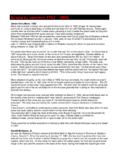Transcription of CHAPTER 5
1 125 CHAPTER 5 Choosing the type of probability samplingINTRODUCTIONOnce a choice is made to use a probability sample design, one must choose the type of probability sampling to use. This CHAPTER includes descriptions of the major types of probability sampling. It covers steps involved in their adminis-tration, their subtypes, their weaknesses and strengths, and guidelines for choosing among are four major types of probability sample designs: simple random sampling, stratified sampling, systematic sampling, and cluster sampling (see Figure ). Simple random sampling is the most recognized probability sam-pling procedure.
2 Stratified sampling offers significant improvement to simple random sampling. Systematic sampling is probably the easiest one to use, and cluster sampling is most practical for large national surveys. These sampling procedures are described you will learn in this CHAPTER : The types of probability sampling and how they differ from each other Steps in carrying out the major probability sample designs The strengths and weaknesses of the various types of probability sampling Differences between stratified sampling and quota sampling Differences between stratified sampling and cluster sampling Differences between multistage cluster sampling and multiphase sampling126 Sampling EssentialsSIMPLE RANDOM SAMPLINGWhat Is Simple Random Sampling?
3 Simple random sampling is a probability sampling procedure that gives every element in the target population, and each possible sample of a given size, an equal chance of being selected. As such, it is an equal probability selection method (EPSEM).What Are the Steps in Selecting a Simple Random Sample?There are six major steps in selecting a simple random sample: 1. Define the target population. 2. Identify an existing sampling frame of the target population or develop a new one. 3. Evaluate the sampling frame for undercoverage, overcoverage, multiple coverage, and clustering, and make adjustments where necessary. 4. Assign a unique number to each element in the frame.
4 5. Determine the sample size. 6. Randomly select the targeted number of population Major Types of Probability SamplingClusterSamplingStratifiedSamplin gSystematicSampling Simple Random SamplingProbabilitySample Designs127 CHAPTER 5 Choosing the Type of Probability SamplingThree techniques are typically used in carrying out Step 6: the lottery method, a table of random numbers, and randomly generated numbers using a computer program ( , random number generator). In using the lottery method (also referred to as the blind draw method and the hat model ), the numbers representing each element in the target population are placed on chips ( , cards, paper, or some other objects).
5 The chips are then placed in a container and thoroughly mixed. Next, blindly select chips from the container until the desired sample size has been obtained. Disadvantages of this method of selecting the sample are that it is time-consuming, and is limited to small table of random numbers may also be used. The numbers in a table of random numbers are not arranged in any particular pattern. They may be read in any manner, , horizontally, vertically, diagonally, forward, or backward. In using a table of random numbers, the researcher should blindly select a start-ing point and then systematically proceed down (or up) the columns of num-bers in the table.
6 The number of digits that are used should correspond to the total size of the target population. Every element whose assigned number matches a number the researcher comes across is selected for the sample. Num-bers the researcher comes across that do not match the numbers assigned the elements in the target population are ignored. As in using the lottery method, using a table of random numbers is a tedious, time-consuming process, and is not recommended for large populations. Instead, statistical software should be used for large populations. Most statistical software and spreadsheet software have routines for generating random numbers.
7 Elements of the populations whose assigned numbers match the numbers generated by the software are included in the sample. One may select a number from a table of random num-bers for use as the starting number for the Are the Subtypes of Simple Random Sampling?There are two types of simple random sampling: sampling with replacement and sampling without replacement. In sampling with replacement, after an element has been selected from the sampling frame, it is returned to the frame and is eligible to be selected again. In sampling without replacement, after an element is selected from the sampling frame, it is removed from the population and is not returned to the sampling frame.
8 Sampling without replacement tends to be more efficient than sampling with replacement in producing representative samples. It does not allow the same population element to enter the sample more than once. Sampling without replacement is more common than sampling with replacement. It is the type that is the subject of this EssentialsWhat Are the Strengths and Weaknesses of Simple Random Sampling?Simple random sampling has the major strengths and weaknesses of probability sampling procedures when compared to nonprobability sam-pling procedures. Notably, among its strengths, it tends to yield representa-tive samples, and allows the use of inferential statistics in analyzing the data collected.
9 Compared to other probability sampling procedures, simple ran-dom sampling has several strengths that should be considered in choosing the type of probability sample design to use (see Table ). Some of these include: Advanced auxiliary information on the elements in the population is not required. Such information is required for other probability sampling procedures, such as stratified sampling. Each selection is independent of other selections, and every possible com-bination of sampling units has an equal and independent chance of being selected. In systematic sampling, the chances of being selected are not independent of each other.
10 It is generally easier than other probability sampling procedures (such as multistage cluster sampling) to understand and communicate to others. Statistical procedures required to analyze data and compute errors are easier than those required of other probability sampling procedures. Statistical procedures for computing inferential statistics are incorporated in most statistical software and described in most elementary statistics the other hand, simple random sampling has important weaknesses. Compared to other probability sampling procedures, simple random samplings have the following weaknesses: A sampling frame of elements in the target population is required.
















![WELCOME [www.primehealthservices.com]](/cache/preview/3/d/1/b/f/2/d/e/thumb-3d1bf2de5dacf21b70c2f7993672d0c4.jpg)